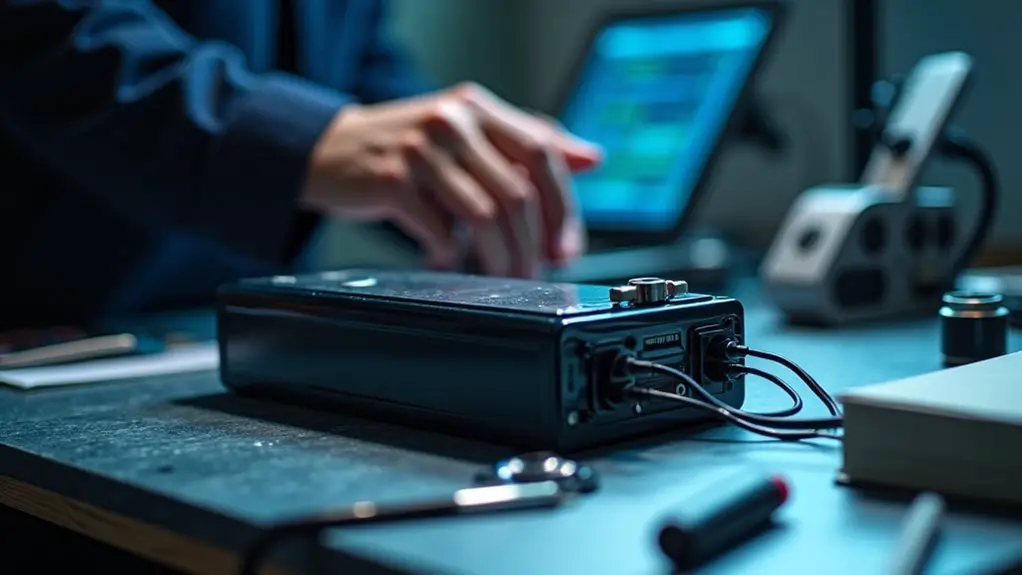You want your lithium battery to last? Simple: calibrate it every three years and avoid overcharging like it’s a bad hangover. Most folks ignore this stuff, but those who actually care can score an extra couple of years out of their investment. You never know when that battery life will make or break your next project, right? But let’s not put the cart before the horse; there’s more to this game than just charging smart.
Key Takeaways
- Regular calibration every three years ensures battery capacity remains above 96% and maintains accurate performance readings.
- Evenly distribute loads across batteries to prevent premature aging and enhance overall battery longevity.
- Monitor charging cycles to avoid overcharging, which can significantly shorten battery lifespan.
- Use compatible equipment like Victron SmartSolar MPPT and avoid high settings on solar charge controllers to protect lithium batteries.
- Engage with the battery community to share experiences and learn effective management strategies for better performance.
Understanding Battery Capacity and Calibration
All right, let’s tackle battery capacity and calibration like we’re chatting over a beer. You’ve got lithium batteries, and you want them to stick around, right?
Here’s the thing: calibration can be your best buddy. Recalibrating every three years? It’s not just a suggestion; it’s a lifesaver, especially if you want to keep that capacity over 96%.
Calibration is your best buddy; do it every three years to keep that battery capacity above 96%.
You won’t need to do it every year if they’re stable—so that’s good news. Just remember, a full charge is key for accurate results.
If they’re not fully cycled, calibrate on event-based triggers, or you’ll be stuck guessing like it’s a bad trivia night.
Factors Affecting Battery Longevity
So, you’ve got your lithium batteries calibrated and purring like a well-tuned engine.
Now, let’s keep them that way. Spread the load evenly across those five dudes; too much stress on one can turn a long-term investment into a short-term tragedy.
Gentle usage? Yes, please. Treat your batteries like a fine wine, not a cheap beer.
Aging factors matter, too—time spent under pressure saps longevity, so think before you push it to the limit.
Regular monitoring? It sounds tedious, but losing just 4% capacity over four years ain’t bad. Trust me, you’ll want to avoid getting stuck with aging batteries.
Importance of State of Charge Calibration
If you think you can just set your lithium batteries and forget about them, think again. Calibration of State of Charge (SOC) is essential for keeping your battery performance in check. Messing this up can mean inaccurate readings, and nobody wants that. Trust me; it’s like using a map from the ’90s when you’ve got GPS.
| SOC Issue | Impact on Performance | Solution |
|---|---|---|
| Aging Factors | Reduced capacity | Regular calibration |
| Overcharging | Shorter lifespan | Monitor charging cycles |
| Usage Patterns | Drift in readings | Full charge cycles |
| Incorrect Estimates | Misleading status | Engage with community |
| Neglecting Maintenance | Drop in efficiency | Routine checks |
Get it done right, or watch those batteries tank.
Best Practices for Solar Charging Systems

Now that you’ve got State of Charge calibration on your radar, let’s talk solar charging systems.
First off, those solar charge controllers—don’t crank ‘em up too high. Lithium batteries hate long absorption times. You want your setup to play nice, not stress them out.
Keep an eye on charging cycles; too much sun is, well, too much. Adjust settings; it’s not rocket science.
And make sure you’re using compatible gear like Victron SmartSolar MPPT. It’s not as fun as a bar fight, but it’s alright.
Effective Battery Management Techniques
When you want your lithium batteries to last longer and perform better, you’ve gotta pay attention to how you manage them.
First off, charge ’em right—overdoing it leads to early death. Keep ’em balanced. Spread that load like too much cheese on a pizza; nobody likes a soggy slice.
Charge your batteries correctly—too much juice can lead to early demise. Balance is key; no one wants a soggy, overloaded slice!
Calibrate every three years, not annually. Think of it like your car—check its health sometimes before it decides to leave you stranded.
Track state of charge carefully, since even a small drift can mess with your plans. Simple, right? Just don’t neglect them, or you’ll be crying over dead batteries before you know it.
Community Insights and Shared Experiences
While many users might think they’ve got it all figured out, the truth is that sharing experiences in the battery community can be your golden ticket to smarter management.
Look, you’re not reinventing the wheel here. Others have faced the same battery blues. They’ve learned to balance load to keep batteries happy and avoid premature aging.
Want to dodge charging mishaps? Chat it up! User tips about battery care can save you headaches—and money.
Overcoming Common Installation Challenges

If you think installing lithium batteries is a walk in the park, you’re in for a reality check.
It’s essential to avoid common pitfalls, like mismatched voltages. Trust me, setting the right solar charge controller voltage is key to preventing premature aging.
Avoid mismatched voltages—properly set your solar charge controller to prevent your lithium batteries from aging prematurely.
Also, don’t skip on securing connections; those little guys are important. Things can go south if you’re too relaxed about placement—vibration isn’t your friend.
And hey, you don’t want to find yourself fumbling with calibration every three years, right?
Future Trends in Battery Technology and Management
So you’ve managed to get those lithium batteries installed without blowing a fuse—great job!
Now, let’s talk trends. You’ll see smarter battery management systems emerging, adapting to your usage and weather like they’ve got a crystal ball. Think AI predicting when to crank the charge up or down—fancy, right?
Plus, as solar tech keeps evolving, batteries and panels will sync better, meaning less time worrying about aging.
And hey, community sharing will explode; user hacks will be gold for avoiding pitfalls.
Stay tuned; it’s a wild ride ahead, but you’re steering this ship—keep those batteries happy, and they’ll treat you right!
Frequently Asked Questions
How Often Should I Recalibrate My Lithium Batteries?
You should recalibrate your lithium batteries every three years, unless they’re behaving themselves.
If they’re stable, skip the annual ritual. But if you notice funky capacity dips, it’s time to whip them back into shape.
Full charge cycles help with accuracy, and hey, every little bit counts.
Just remember, if they’re averaging 4% loss over four years, you’re doing alright.
What Are the Signs of Battery Capacity Loss?
You’ll know your battery’s capacity is headed south when it’s losing charge faster than a phone on 1%.
You might notice slower performance or shorter run times. If charging takes longer than usual, that’s your first red flag.
Plus, if it’s struggling to maintain a charge level, you’re in trouble.
Just remember: 4% capacity loss over four years is acceptable, but losing half your juice in two? That’s a battery crisis, my friend.
Can Extreme Temperatures Affect Battery Performance?
Yeah, extreme temperatures can seriously mess with battery performance.
If it’s too hot, you risk overheating, which can lead to capacity loss—around 20% in severe cases.
Cold weather? It’s like pushing the snooze button on your battery’s power. You’ll notice reduced efficiency and shortened run time.
What Is the Ideal Charging Voltage for Lithium Batteries?
The ideal charging voltage for lithium batteries? It’s usually between 4.2 to 4.3 volts per cell.
Go any higher, and you’re flirting with disaster—think overheating, swelling, or even fires.
Now, if you’re charging multiple batteries, keep it balanced to avoid stressing one out more than the others.
It’s like managing a group of friends—too much attention on one, and the entire night’s ruined.
Are There Specific Brands That Optimize Battery Longevity?
Yeah, some brands do a better job at extending battery life.
Look at Lithionics and Battle Born. They’ve got great reputations for longevity—those batteries maintain around 96% capacity, even after some years.
But hey, it’s not just the brand; how you use and charge them matters too.
Be nice to your batteries—don’t push ‘em too hard or they’ll ghost you sooner.
Summing Up
So, here’s the deal: treat your lithium battery right, and it’ll stick around and work hard for you. Regular calibration? Check. Full charge cycles? Definitely. Don’t overcharge it like that friend who can’t handle their tequila. You’re looking at longer lifespan and better performance, which means more bang for your buck. Share tips with the battery nerds out there, because, let’s face it, they know a thing or two. Now get out there and keep that battery happy!

